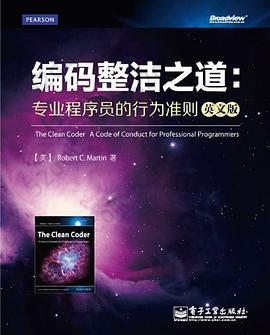注重体验与质量的电子书资源下载网站
分类于: 互联网 人工智能
简介

编码整洁之道: 专业程序员的行为准则(英文版) 豆 8.7分
资源最后更新于 2020-08-19 16:08:41
作者:罗伯特·C.马丁
出版社:电子工业出版社
出版日期:2012-01
ISBN:9787121175633
文件格式: pdf
标签: 编程 计算机 软件开发 软件工程 编码规范 Programming 重构 英文版
简介· · · · · ·
忍受各种不确定性及不间断的压力并能够获取成功的程序员有一个共通特征:他们都深度关注软件创建实践。他们都把软件看做一种工艺品。他们都是专家。在“鲍勃大叔”看来“专业”的程序员不仅应该具备专业的技能,更应该具备专业的态度,这也是本书阐述的核心。专业的态度包括如何用带着荣誉感、自尊、自豪来面对进行软件开发,如何做好并做得整洁,如何诚实地进行沟通和估算,如何透明并坦诚地面对困难做抉择,如何理解与专业知识相伴的责任。
点击链接进入: 代码整洁之道
目录
Foreword
Preface
Acknowledgments
About the Author
On the Cover
Pre-Requisite Introduction
Chapter 1 Professionalism
Be Careful What You Ask For
Taking Responsibility
First, Do No Harm
Work Ethic
Bibliography
Chapter 2 Saying No
Adversarial Roles
High Stakes
Being a “Team Player”
The Cost of Saying Yes
Code Impossible
Chapter 3 Saying Yes
A Language of Commitment
Learning How to Say“Yes”
Conclusion
Chapter 4 Coding
Preparedness
The Flow Zone
Writer’s Block
Debugging
Pacing Yourself
Being Late
Help
Bibliography
Chapter 5 Test Driven Development
The Jury Is In
The Three Laws of TDD
What TDD Is Not
Bibliography
Chapter 6 Practicing
Some Background on Practicing
The Coding Dojo
Broadening Your Experience
Conclusion
Bibliography
Chapter 7 Acceptance Testing
Communicating Requirements
Acceptance Tests
Conclusion
Chapter 8 Testing Strategies
QA Should Find Nothing
The Test Automation Pyramid
Conclusion
Bibliography
Chapter 9 Time Management
Meetings
Focus-Manna
Time Boxing and Tomatoes
Avoidance
Blind Alleys
Marshes, Bogs, Swamps, and Other Messes
Conclusion
Chapter 10 Estimation
What Is an Estimate?
PERT
Estimating Tasks
The Law of Large Numbers
Conclusion
Bibliography
Chapter 11 Pressure
Avoiding Pressure
Handling Pressure
Conclusion
Chapter 12 Collaboration
Programmers versus People
Cerebellums
Conclusion
Chapter 13 Teams and Projects
Does It Blend?
Conclusion
Bibliography
Chapter 14 Mentoring, Apprenticeship, and Craftsmanship
Degrees of Failure
Mentoring
Apprenticeship
Craftsmanship
Conclusion
Appendix A Tooling
Tools
Source Code Control
IDE/Editor
Issue Tracking
Continuous Build
Unit Testing Tools
Component Testing Tools
Integration Testing Tools
UML/MDA
Conclusion
Index
Preface
Acknowledgments
About the Author
On the Cover
Pre-Requisite Introduction
Chapter 1 Professionalism
Be Careful What You Ask For
Taking Responsibility
First, Do No Harm
Work Ethic
Bibliography
Chapter 2 Saying No
Adversarial Roles
High Stakes
Being a “Team Player”
The Cost of Saying Yes
Code Impossible
Chapter 3 Saying Yes
A Language of Commitment
Learning How to Say“Yes”
Conclusion
Chapter 4 Coding
Preparedness
The Flow Zone
Writer’s Block
Debugging
Pacing Yourself
Being Late
Help
Bibliography
Chapter 5 Test Driven Development
The Jury Is In
The Three Laws of TDD
What TDD Is Not
Bibliography
Chapter 6 Practicing
Some Background on Practicing
The Coding Dojo
Broadening Your Experience
Conclusion
Bibliography
Chapter 7 Acceptance Testing
Communicating Requirements
Acceptance Tests
Conclusion
Chapter 8 Testing Strategies
QA Should Find Nothing
The Test Automation Pyramid
Conclusion
Bibliography
Chapter 9 Time Management
Meetings
Focus-Manna
Time Boxing and Tomatoes
Avoidance
Blind Alleys
Marshes, Bogs, Swamps, and Other Messes
Conclusion
Chapter 10 Estimation
What Is an Estimate?
PERT
Estimating Tasks
The Law of Large Numbers
Conclusion
Bibliography
Chapter 11 Pressure
Avoiding Pressure
Handling Pressure
Conclusion
Chapter 12 Collaboration
Programmers versus People
Cerebellums
Conclusion
Chapter 13 Teams and Projects
Does It Blend?
Conclusion
Bibliography
Chapter 14 Mentoring, Apprenticeship, and Craftsmanship
Degrees of Failure
Mentoring
Apprenticeship
Craftsmanship
Conclusion
Appendix A Tooling
Tools
Source Code Control
IDE/Editor
Issue Tracking
Continuous Build
Unit Testing Tools
Component Testing Tools
Integration Testing Tools
UML/MDA
Conclusion
Index








